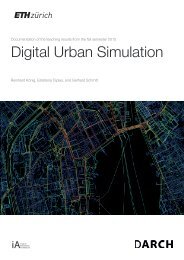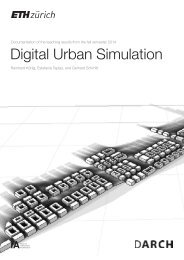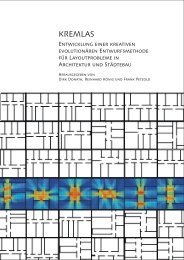New methods in urban analysis and simulation
Documentation of teaching results from the spring semester 2015 of the seminar Digital Urban Simulation at the Chair of Information Architecture, ETH Zurich
Documentation of teaching results from the spring semester 2015 of the seminar Digital Urban Simulation at the Chair of Information Architecture, ETH Zurich
You also want an ePaper? Increase the reach of your titles
YUMPU automatically turns print PDFs into web optimized ePapers that Google loves.
6<br />
< conclusion ><br />
In this project, I can get the the result which is closest to the exist<strong>in</strong>g enviroment by axial-l<strong>in</strong>e <strong>analysis</strong> for public<br />
space <strong>and</strong> approachs of connection. The better solution still can be judged by same <strong>analysis</strong> among several proposal.<br />
The reason is that axial-l<strong>in</strong>e <strong>analysis</strong> provides us most <strong>in</strong>tuitive results on the spatial cont<strong>in</strong>uity <strong>and</strong> possible<br />
distribution.<br />
Besides, the type of spaces we analyzed is ma<strong>in</strong>ly focused on public space at pedestrian’s aspect. We can run<br />
our <strong>analysis</strong> on the map that only exist<strong>in</strong>g build<strong>in</strong>g blocks. It also can provides the suitable slocation from human<br />
scale. Comb<strong>in</strong><strong>in</strong>g two po<strong>in</strong>ts mentioned above, if we want to f<strong>in</strong>d a further result, we still need to clearify the circulation<br />
between pedestrian <strong>and</strong> vehicles, the purpose of visiters <strong>and</strong> locals, convenience <strong>and</strong> liv<strong>in</strong>g quality.<br />
I F<strong>in</strong>al project documentation<br />
57








